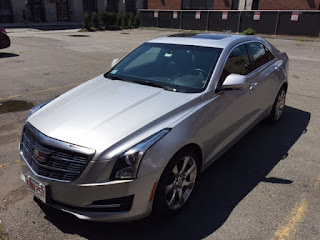According to everyone who tracks this stuff, General Motors is actually making good cars now.
I
drove a 2014 Chevrolet Corvette Stingray recently, and I enjoyed that very much. My internet sources (Jeremy Clarkson of British Top Gear primarily) reinforce that notion. Even by European standards, they grudgingly admit, the Corvette is a very good car.
I took the opportunity yesterday to drive another GM product, the Cadillac ATS, a car that’s also receiving praise. Cadillac is the platform GM is going to use to challenge the BMW M series cars.
For me, American cars are mostly about overcoming my prejudices. I am still scarred by the terrible products coming out of Detroit in the 1970s. There was a disconnect: terrible quality control, abysmal labor-management relations, and huge, inefficient automobiles couldn’t convince American carmakers there was anything wrong. (This has all be very well reported by
This American Life in their 2010 story on the Fremont, California GM plant and their struggles to implement Toyota management techniques.) Eventually, Japanese manufacturers, aided by the Arab Oil Embargo of 1973, started the inexorable process of sweeping the Americans from centerstage. A friend of mine captured the whole saga very well: "My father was a U.S. combat engineer in World War II. He fought against the Germans and bought only American cars on principle. That is until he tried his first Toyota in 1982. Then he never bought another American car again after that.”
Cadillac’s problem for a while now has been that their average customer is old. It’s hard to make a brand sexy for the future when your quintessential user is a retired executive driving to the golf course. How to create a new image that appeals to the next generation? Therein lies the question.
As it turns out, the Cadillac ATS is a better looking car than I was expecting. In pictures, it appears unappealing and boxy, but in person, it’s sleeker and more stylish.
It’s a car with a sufficient amount of power, easily managing the speed limit and then some. It accomplishes something else that impresses me, comfortably traveling at a highway clip but revving at only slightly over 1,500 rpm. Perhaps I shouldn’t be surprised by this feat, but I am.
Its handling in the corners is really very good. Holding very tight to the road in the curves, it nevertheless balloons when it hits rough patches in the tarmac. Balloon means it has that boat-like bounce that so many American cars have, or at least used to have, when they sway disturbingly at speed. How does a car handle the corners well, but seem a little untied on rough surfaces at speed? I don’t really know.
The cabin is spacious and the visibility is acceptable.
Those are the good points. The bad points are these — I found the seat uncomfortably hard and oddly configured. It sat a little too low, and I found the steering wheel to be too tight to my body. (This is in striking comparison to the Chrysler 200 I drove a few weeks ago which was amazingly comfortable and ergonomic over distance.)
The instrument cluster is very poorly designed and hard to use. Touch screen is everywhere, but almost impossible to navigate, though I believe in the newer models, the designers have gone back to knobs and dials, which would be a great improvement. The steering wheel buttons are badly configured.
There is a definite blind spot over the driver’s right shoulder and the front pillars are thick and block sightlines when looking forward. The side view mirrors were hard to configure to get just right. Overall, fit and finish was good, though the door handles seemed a little cheap.
For such a big car, the ATS has a relatively small engine, coming in at either 2L or 2.5L or a larger V6. The brakes stop the car well.
Priced starting in the mid-30s, the car gets Cadillac in the game and does it well. Would I recommend taking it on the windy roads in Lincoln, Concord and Sudbury? Sure, it’s a fun drive and a quality car.
Would I buy it for myself? No, I wouldn’t, but I’m not the measure of that gauge. I’m still driving an old beat up Subaru.















